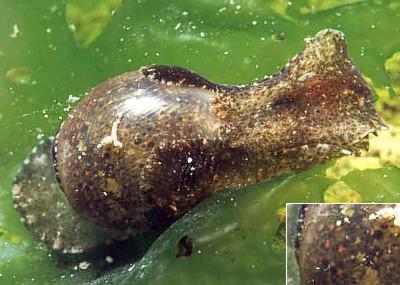
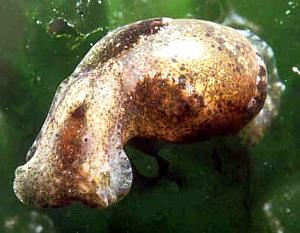
Haminoea hydatis
(Linnaeus, 1758)
Order: CEPHALASPIDEA
Superfamily: HAMINOEOIDEA
Family: Haminoeidae
DISTRIBUTION
Occasionally found on south and west coast of British Isles. More common from Atlantic coast of France to the Mediterranean.
PHOTO
Sète, South of France, Mediterranean Sea. 2 December 2000. 6m in algae Ulva rigida and on the surrounding sand. Size: 2 cm. Photos: Jean-Pierre Bielecki
Fragile inflated shell grows to about 15mm in length and body to about 30mm. The parapodial lobes are relatively small for this genus, leaving most of the shell exposed.
Compare with Haminoea navicula.
References:
• Alvarez, L.A., Garcia, F.J. & Villani, G. (1993) A new Mediterranean species of Haminaea Leach, 1820 (Gastropoda: Opisthobranchia: Cephalaspidea). J. Moll. Stud. 59: 339-345.
• Boulch-Bleas, D. (1983) About the diet of Haminea hydatis (Linne, 1758) (Opisthobranch, Mollusc). Haliotis, 13: 45-52.
• Talavera, P., Murillo, L. & Templado, J. (1987) The genus Haminoea Turton and Kingston, 1830 (Opisthobranchia, Bullomorpha) in the southeast of Spain with the description of a new species. Bollettino Malacologico, 23(1-4): 53-68.
• Thompson, T.E. (1976) Biology of Opisthobranch Molluscs, Vol 1. Ray Society: London.
• Thompson, T.E. (1988) Molluscs: Benthic Opisthobranchs. 356pp. Synopses of the British Fauna (New Series) No. 8. E.J.Brill & W. Backhuys: Leiden.
Rudman, W.B., 2001 (February 13) Haminoea hydatis (Linnaeus, 1758). [In] Sea Slug Forum. Australian Museum, Sydney. Available from http://www.seaslugforum.net/find/hamihyda
Related messages
Re: Mass spawning in Haminoea cymbalum
February 21, 2007
From: Levent Cavas
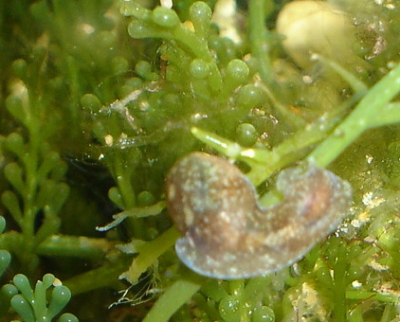
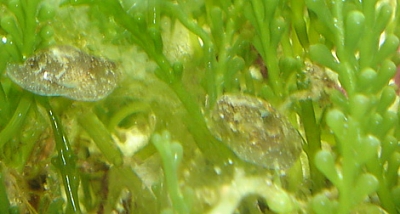
Concerning message #19447:
Dear Bill,
I really wonder the green alga species around Haminoea cymbalum groups in Philibert's photo. I have been observing Haminoea hydatis around izmir-Turkiye coastlines and they are very abundant around invasive Caulerpa racemosa var.cylindracea meadows. In my aquarium experiments, Haminoea hydatis tended to leave their egg mass especially on Caulerpa fronds although my aquarium contains other sea plants such as Halophila sp, Posidonia etc. is there anybody who has similar observation with me?
I think, caulerpenyne, secondary metabolite of Caulerpales, can be effective in this interaction.
Best wishes
Levent Cavas
Dokuz Eylul Uni.
Izmir-Turkiye
lcavas@deu.edu.tr
Cavas, L., 2007 (Feb 21) Re: Mass spawning in Haminoea cymbalum. [Message in] Sea Slug Forum. Australian Museum, Sydney. Available from http://www.seaslugforum.net/find/19471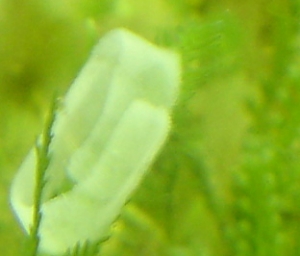
Dear Levent,
I suspect they prefer a hard suface to lay their eggs on. On sandy shores eggs are often deposited on old bivalve shells and rocks. In the photo alongside the egg ribbon appears to be a flattened ribbon. I would have expected a species of Haminoea to have a more cylindrically shaped egg ribbon. It looks rather different from you earlier photo [#11977 ].
Best wishes,
Bill Rudman
Haminoea from Turkey
January 21, 2004
From: Levent Cavas
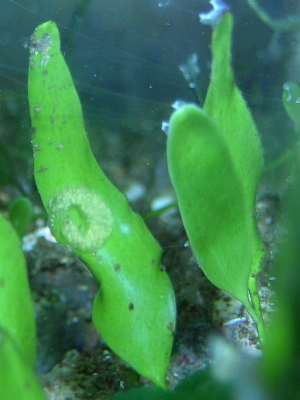
Dear Dr.Rudman,
Here are some egg pictures that I could not identify. Others have identified them as Oxynoe and Lobiger. However, I have just seen an animal that I also could not identify, when it was laying eggs in my aquarium. These eggs belong to this animal however I do not know its species.
I have attached the pictures of this animal.
Best regards
Levent CAVAS,
Dokuz Eylul University
Izmir, Turkey
lcavas@deu.edu.tr
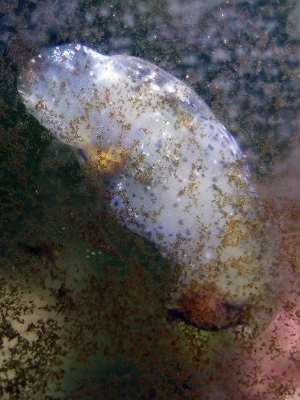
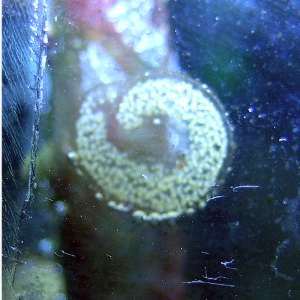
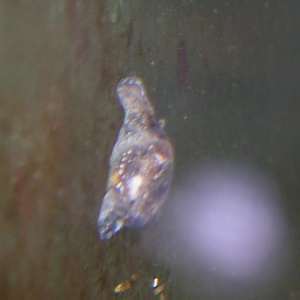
Dear Leven,
Its a bit risky identifying egg ribbons except in a few cases when a species has a very characteristic shape. However the two photos of the animal show it to be a cephalaspidean bubble shell and most probably a species of Haminoea. My guess is that it is Haminoea hydatis but I can't be certain from the photos
Best wishes
Bill Rudman
Haminoea hydatis from Malta
March 3, 2001
From: Constantine Mifsud
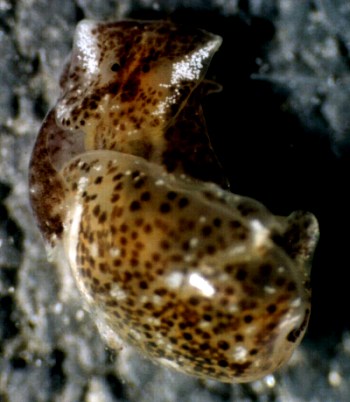
Bill,
In the Mediterranean there are two forms of Haminoea hydatis. A dark form and a lighter coloured form. I am posting a photo of the light coloured form from Malta found in weed washings from 0.5 m depth, in contrast to Jean-Paul's specimen from the Mediterranan coast of France. H. orteai, also from the near Atlantic, is distinguished by the unpigmented area around the eyes.
Regards,
Constantine
kejdon@orbit.net.mt
Mifsud, C., 2001 (Mar 3) Haminoea hydatis from Malta. [Message in] Sea Slug Forum. Australian Museum, Sydney. Available from http://www.seaslugforum.net/find/3878Thanks Constantine,
Its nice to see some shelled opisthobranchs for a change
Best wishes,
Bill Rudman.
Haminoea from France
February 13, 2001
From: Jean-Pierre Bielecki


Dear Bill
Can you help me to find the species of the following Cephalaspidae, [Bullidae family] found in the Mediterranean Sea, 2 December, 2000.
Dive site : étang de thau, Sète, South of France. Depth : 6m in algae Ulva rigida and on the surrounding sand. Size : 2 cm. Water temperature : 12°C
Best regards.
Jean-Pierre Bielecki
bielecki.jeanpierre@free.fr
Bielecki, J-P, 2001 (Feb 13) Haminoea from France. [Message in] Sea Slug Forum. Australian Museum, Sydney. Available from http://www.seaslugforum.net/find/3793Dear Jean-Pierre,
From the transparent shell I would say this is not a species of Bulla but a species of Haminoea [Family Haminoeidae].
I am not an expert on the European species of Haminoea, but the two most common species would seem to be H. hydatis and Haminoea navicula. Thompson (1976) says that in H. navicula the mantle, which can be seen through the transparent shell, has brown spots and orange blotches (see inset in photo) so I am guessing that this is H. navicula.
If someone will confirm that identity, I'll make a page for this species. Species of Haminoea are herbivores, and it seems in temperate waters, most species feed on the algae Ulva and Enteromorpha and sometimes the organic film found covering either the soft sea bed or sea-grass leaves.
Best wishes,
Bill Rudman
Note added 15 Feb 2001: See Bernard Picton's message suggesting this is Haminoea hydatis
Rudman, W.B., 2001 (Feb 13). Comment on Haminoea from France by Jean-Pierre Bielecki. [Message in] Sea Slug Forum. Australian Museum, Sydney. Available from http://www.seaslugforum.net/find/3793